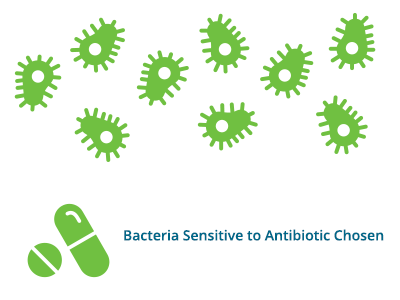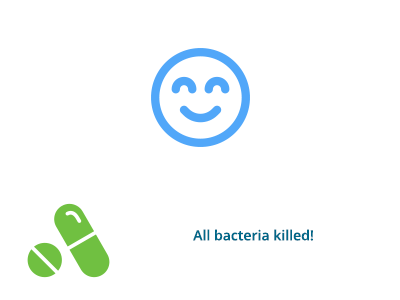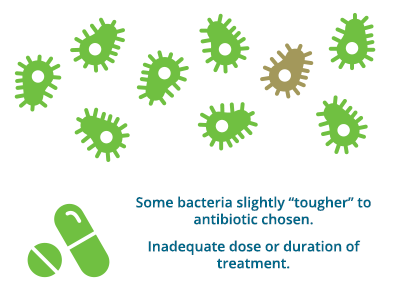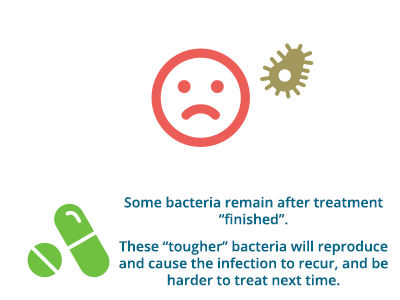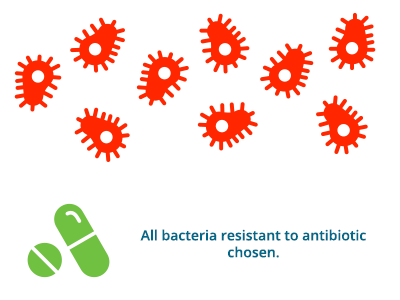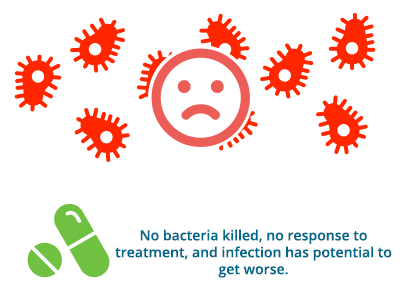ANTIBIOTIC ADVICE
How we are trying to promote sensible and appropriate usage of antibiotics!
Antibiotic Resistance and our role as Pet Owners and Vets
'Antibiotic resistance' and threat of "superbugs' are terms we hear about in the media all the time. It is easy to think of it as somebody else's problem, but we all have a role to play in order to ensure we are able to continue to use these lifesaving drugs in the future.
As a pet owner it is extremely important that the instructions given by your Veterinary Surgeon for antibiotic treatments for your pets are followed correctly.
What are antibiotics?
Antibiotics are groups of drugs that either kill bacteria (bactericidal) or inhibit their growth (bacteriostatic). There are different types of bacteria, each of which is sensitive to specific antibiotics; therefore it is very important that we are selective and specific about which drugs we use. Antibiotic treatments can come in a variety of forms, including:
- Tablets
- Capsules
- Oral Liquid
- Injections
- Topical Preparations (such as Ear Drops, Eye ointment etc)
What is Antibiotic-resistance?
Inappropriate use of antibiotics can lead to the development of bacteria that are resistant (unaffected) by the drugs commonly used.
When the antibiotic used has only been partially effective- the strongest bacteria survive treatment and multiply and grow, leaving the body unable to defend itself against this infection. This leads to spread of this bacteria which is very difficult to treat between people, pets, food and the environment; causing increased risk to health and therefore more cases of severe illnesses or death due to lack of effective medications available to defend against these infections. There are already bacteria species causing serious risk to both human and animal health that are resistant to multiple drugs, such as MRSA (Methicillin-resistant Staphylococcus aureus)
and multi-resistant Pseudomonal
Infections (becoming more common in animals)
Unsurprisingly antibiotic resistance is a serious and worrying health risk to both humans and animals. Minor illnesses that are currently quickly treated with antibiotics may become life-threatening due to the development of resistance.
Sensitive or Resistant?(Slide over graphics for the explanations)
Correct Use...
Incorrect Dose or Duration...
Incorrect Choice...
When are antibiotics prescribed?
Only diseases caused by bacteria are appropriate to be treated by antibiotics. Examples of conditions not treatable/ not appropriate for treatment with antibiotics:
- Viral
- Fungal
- Acute Diarrhoea (Short term)
- Salmonella infections
- Cystitis in young cats
- Vomiting
- Kennel Cough
In a lot of cases diagnostic tests need to be done and samples will be sent to the laboratory to check what species of bacteria are present and to determine what antibiotic they will be sensitive to - a process call Culture and Sensitivity.
What is "Culture and Sensitivity"?
Culture and Sensitivity
is where a sample of the infected material is taken (usually as a swab, needle aspirate or tissue sample) and then sent to a laboratory.
At the lab, the samples are grown in petri-dish cultures along with a variety of antibiotic discs. We then get a report back which states:
- Which bacterial species are present (indeed if any).
- Which antibiotics the bacteria is most sensitive to.
We don't always perform a Culture and Sensitivity, but there may be occasions where it may be prudent to do so. These may include:
- SEVERE or ACUTE infections.
- "Unexpected" infections such as post-surgery or wound infections.
- Infections where resistance is often encountered - such as ear infections.
- Any infection that hasn't responded to a course of antibiotics that we would normally "expected" to have worked.
Simple rules about giving antibiotics to your pets.
Do not treat without veterinary advice!
Do not give antibiotics for another pet or some you have left over etc. Every pet and illness is different and antibiotics must be prescribed by your Vet individually each time.
Give the dose recommended by the vet!
Increasing the dose will not speed up the recovery time and could cause toxicities. Reducing a dose will not completely treat the infection and is more likely to lead to resistance.
Give for the correct length of time & always finish the course.
Always finish the course- do not stop early even if the symptoms you were treating for have resolved. You should not have any left over at the end.
Always give at the correct time of day and time intervals.
For example, if told "twice daily"; try to give near to 12 hours apart or if "once a day"; always give at the same time each day.
Eye drops should always be given at least 10 minutes apart unless told otherwise.
Follow specific instructions.
Such as "Always give with Food" or "Avoid dairy products".
Look at any instructions about whether to reduce the dose, or if the medication needs special handling.
Always revisit the vet if you have been asked to.
Recheck appointments are often scheduled to make sure the infection has completely resolved. Otherwise a longer course may be required.
If you are struggling to administer the medication contact your vet. There may be alternative ways or tips we can give to help with any difficulties.
